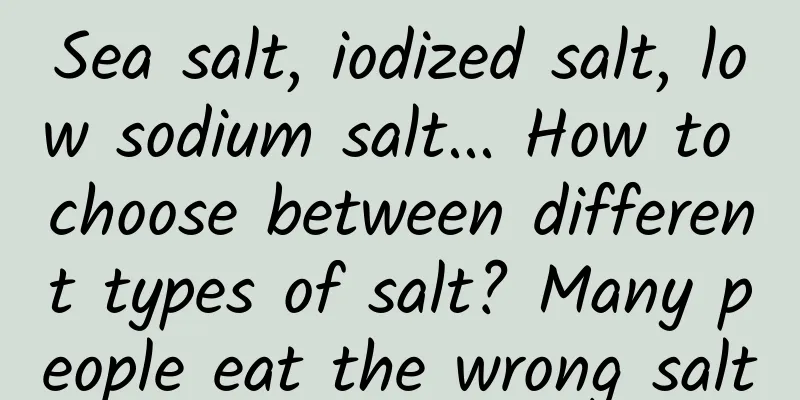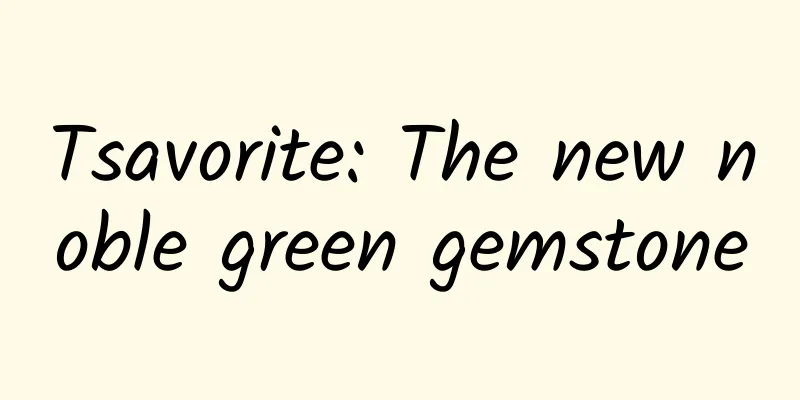Sea salt, iodized salt, low sodium salt... How to choose between different types of salt? Many people eat the wrong salt

|
In the past two days, "buying salt" and "hoarding salt" have attracted everyone's attention. When people go to the supermarket to buy salt, they see well salt, lake salt, sea salt, low sodium salt, iodized salt, non-iodized salt... How to choose among various salts? If we sort by "source and type", there are well salt, lake salt, and sea salt; if we sort by "ingredients", there are low-sodium salt, iodized salt, and non-iodized salt. Do different groups of people eat different salts? Check to see if you are eating the right salt! Weibo screenshot What is the difference between different types of salt? The sources of salt in my country are mainly divided into three categories: well salt, lake salt and sea salt. According to China Salt Industry Group, the current product structure of salt in my country is 87% well salt, 10% sea salt and 3% lake salt. ▼ Sea salt: seawater is introduced into salt pans and then exposed to the sun, evaporated, and crystallized; ▼ Lake salt (pond salt): salt mined directly from salt lakes, or made from salt lake brine in salt pans; ▼ Mineral salt (rock salt): Mined from salt deposits, rock salt is buried 100 to 3,000 meters underground. ▼ Bamboo Salt: Seal the coarse salt in a bamboo tube with yellow mud and calcine it at high temperature, which not only removes the impurities in the salt, but also leaves a hint of bamboo fragrance. Gu Chuanling, deputy secretary-general of the Capital Health Nutrition and Gourmet Society, published an article in Health Times in 2017, saying that the quality of well salt is higher than that of lake salt and sea salt, because the raw materials of well salt come from natural brine and rock salt deposits below a thousand meters deep, so they are almost not polluted and have few impurities. How to choose salt with different ingredients? Although there are many types of salt and the prices vary, the three main types of salt are marked according to the "Nutrition Composition Table": sodium, iodine and potassium. After the former Ministry of Health revised the "Standards for the Use of Food Nutrient Fortifiers" in 2012, salt is no longer allowed to add nutritional fortifiers other than iodine. Low sodium salt - not recommended for people who do heavy physical labor or have kidney disease Low-sodium salt is generally made from iodized salt, with a certain amount of potassium chloride added to improve the balance of sodium and potassium in the body and prevent high blood pressure. Of course, there are also iodine-free low-sodium salts. Ding Xia, deputy chief physician of the Nutrition Department of the Affiliated Hospital of Nantong University, Jiangsu, published an article in Health Times in 2018, introducing that people who are not suitable for high potassium intake, such as those working in high temperatures, those who work with heavy physical labor intensity, those with renal dysfunction, and those with hypertension who take antihypertensive drugs, should use low-sodium salt with caution. Jin Yuqian, a nutritionist in the Nutrition Department of the Run Run Shaw Hospital Affiliated to Zhejiang University, published an article on the hospital's official account in 2021 to explain that because some antihypertensive drugs have a potassium-retaining effect, low-sodium salts relatively increase the potassium content, and blood potassium in the body is prone to increase. Common antihypertensive drugs include spironolactone, triamterene, captopril, valsartan, etc. If you are not sure what medicine you are taking, you can consult a specialist. Iodized salt - suitable for most households Most of the salt we consume in our daily lives is iodized salt. The reason why iodine is added to salt is that my country was once a country with a serious prevalence of iodine deficiency. Since 1996, my country has implemented iodization of salt for all people. There have been various opinions on whether it is necessary to continue to consume iodized salt. Some people believe that my country has supplemented iodine for so many years and does not need to consume iodized salt anymore, and the high incidence of thyroid cancer is related to iodine; others say that coastal areas eat a lot of seafood and can rely on food to supplement iodine; there are also views that iodine deficiency has serious consequences and iodine should continue to be supplemented. The Shanghai Municipal Health Commission once stated that there is no direct evidence that the consumption of iodized salt or increased iodine intake is related to the occurrence of thyroid cancer. Gu Chuanling, deputy secretary-general of the Capital Health Nutrition and Gourmet Society, published an article in Health Times in 2017, saying that except for the high-iodine areas that stopped supplying iodized salt, other areas should continue to eat iodized salt, otherwise the risk of iodine deficiency is very high. For a small number of patients with hyperthyroidism, thyroiditis, autoimmune thyroid disease, etc., whether they can eat iodized salt needs to be followed by a doctor. Non-iodized salt: not recommended for these two types of people In 2017, Song Xiangyang, director of the Department of Thyroid and Breast Surgery at Zhejiang Provincial People's Hospital, pointed out in an interview with the media that there are two types of people who are not suitable for consuming iodized salt: the first type is patients with thyroid diseases such as hyperthyroidism, thyroiditis, and autoimmune thyroid disease. Due to treatment needs, they can not consume or consume less iodized salt according to the doctor's advice; the other type is residents living in high-iodine areas or non-iodine-deficient areas. They already get enough iodine from food and drinking water every day. This group of people should not consume iodized salt. It should be emphasized here that coastal areas are not necessarily high-iodine areas or non-iodine-deficient areas. In 2019, Li Yong, a doctor from the Institute of Nutrition, School of Medicine, Qingdao University, published an article in Health Times, introducing that studies in coastal areas such as Fujian showed that when consuming iodized salt, the dietary iodine intake of adult men in different geographical regions of Fujian Province is generally appropriate and safe, and there is no problem of excessive iodine. Iodized salt is the main source of dietary iodine; it is even believed that if residents of coastal cities do not eat seaweed foods, they will face the risk of iodine deficiency even if they eat iodized salt. |
<<: This is the Chaka Salt Lake, which is enough to feed people for 70 years! Satellite view →
Recommend
A case study accurately analyzes what is product thinking, traffic thinking and user thinking
Many people don’t understand what product thinkin...
What are the advantages of news app development?
In this era of information explosion, are you sti...
How far can a taxi-hailing app that has forgotten its original purpose go?
Frankly speaking, I am a loyal user of taxi-haili...
Do you run to escape reality? Beware of developing "exercise addiction"
Written by: Nan An The New Year has passed, and t...
If you fast for 16 hours, your body will eat itself?! The human body's autophagy function is not that simple
Author: Ye Shi Popular Science Creator Reviewer: ...
Why is the effect of information flow advertising worse after targeted advertising?
We all know that the first step in doing informat...
How to improve product stickiness and user retention?
Most low-frequency, rigid-demand products face th...
256G or 512G? There are some tricks to choosing mobile phone memory
In order to meet the needs of users for storage, ...
Lumia1020 try to play the voice of the girl
Microsoft released the new Windows Phone 8.1 opera...
Tips for attractive job ads!
As we all know, a job advertisement consists of t...
360 Mini Programs are designed for all scenarios, breaking the boundaries between PC and mobile terminals.
On July 5, 2019, the 360 Mini Program public be...
Users hate ads, and monetization has reached a bottleneck? That’s because you didn’t choose the right advertising format!
Nowadays, common and new forms of mobile advertis...
High-conversion information flow account building routine, just use it directly!
Recently, a friend left a message to complain: Th...
What did the Internet giants do on April Fools' Day?
Editor’s Note: Although this year's April Foo...







![[Jingang Talks Finance] Jingang | Band 42 Chapter "Gold" (Upper, Middle, Lower)](/upload/images/67cc01b049beb.webp)

